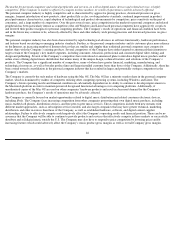Apple 2005 Annual Report Download - page 43
Download and view the complete annual report
Please find page 43 of the 2005 Apple annual report below. You can navigate through the pages in the report by either clicking on the pages listed below, or by using the keyword search tool below to find specific information within the annual report.
AJCA. The legislation provided the Company with the option to apply this provision to repatriations of qualifying earnings in either 2005 or
2006. The Company is continuing to evaluate the effects of the repatriation provision and expects to complete the evaluation in 2006. A
maximum of $755 million may be eligible for repatriation under the reduced tax rate provided by AJCA. However, given the uncertainties and
complexities of the repatriation provision and the Company’s continuing evaluation, the Company has not yet determined the amount that may
be repatriated or the related potential income tax effects of such repatriation.
Recent Accounting Pronouncements
In November 2005, the FASB issued FASB Staff Position (FSP) Nos. FAS 115-1 and FAS 124-1, The Meaning of Other-Than-Temporary
Impairment and its Application to Certain Investments
. FSP Nos. FAS 115-1 and FAS 124-1 amend SFAS No. 115, Accounting for Certain
Investments in Debt and Equity Securities,
SFAS No. 124, Accounting for Certain Investments Held by Not-for-Profit Organizations,
as well as
APB Opinion No. 18, The Equity Method of Accounting for Investments in Common Stock. This guidance nullifies certain requirements of
EITF 03-1, The Meaning of Other-Than-Temporary Impairment and its Application to Certain Investments . FSP Nos. FAS 115-1 and FAS
124-1 include guidance for evaluating and recording impairment losses on debt and equity investments, as well as new disclosure requirements
for investments that are deemed to be temporarily impaired. FSP Nos. FAS 115-1 and FAS 124-1 also require other-than-temporary impaired
debt securities to be written down to its impaired value, which becomes the new cost basis. FSP Nos. FAS 115-1 and FAS 124-1 are effective
for fiscal years beginning after December 15, 2005. Although the Company will continue to evaluate the application of FSP Nos. FAS 115-1
and FAS 124-1, management does not currently believe adoption will have a material impact on the Company’s results of operations or
financial position.
In November 2004, the FASB issued SFAS No. 151, Inventory Costs , which amends the guidance in Accounting Research Bulletin (ARB)
No. 43, Chapter 4,
Inventory Pricing , to clarify the accounting for abnormal amounts of facility expense, freight, handling costs, and wasted
material (spoilage). ARB 43, Chapter 4, previously stated that “under some circumstances, items such as idle facility expense, excessive
spoilage, double freight, and rehandling costs may be so abnormal as to require treatment as current period charges.” SFAS 151 requires that
those items be recognized as current-period charges regardless of whether they meet the criterion of “so abnormal.” In addition, SFAS 151
requires that allocation of fixed production overhead to the costs of conversion be based on the normal capacity of the production facilities.
SFAS 151 is effective for fiscal years beginning after June 15, 2005. Although the Company will continue to evaluate the application of SFAS
151, management does not currently believe adoption will have a material impact on the Company’s results of operations or financial position.
In December 2004, the FASB issued FSP 109-2, Accounting and Disclosure Guidance for the Foreign Earnings Repatriation Provision within
the American Jobs Creation Act of 2004 . FSP 109-2 provides additional time to companies beyond the financial reporting period of enactment
to evaluate the effects of the AJCA on their plans for repatriation of foreign earnings for purposes of applying SFAS 109, Accounting for
Income Taxes
. The Company is currently evaluating the repatriation provisions of AJCA, which if implemented by the Company would affect
the Company’s tax provision and deferred tax assets and liabilities. However, given the uncertainties and complexities of the repatriation
provision and the Company’s continuing evaluation, it is not possible at this time to determine the amount, if any, that will be repatriated or the
related potential income tax effects of such repatriation. The Company expects to complete the evaluation in 2006.
In December 2004, the FASB issued SFAS No. 123 (revised 2004) (SFAS No. 123R), Share-Based Payment
, that addresses the accounting for
share-based payment transactions in which an enterprise receives employee services in exchange for (a) equity instruments of the enterprise or
(b) liabilities that are based on the fair value of the enterprise’s equity instruments or that may be settled by the issuance of such
41
























